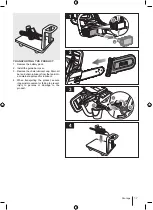
5
Original Instructions
PUSH AND PULL
The reaction force is always opposite to the direction the
chain is moving. The operator must be ready to control the
tendency for the product to pull away and push backwards.
The product pulls away (forward motion) when cutting on
the bottom edge of the bar. The product pushes backwards
(towards the operator) when cutting along the top edge.
SAW JAMMED IN THE CUT
Turn off the product, and remove the battery pack. Do not
try to force the chain and bar out of the cut as this is likely
to break the chain, which may swing back and strike the
operator. This situation normally occurs because the wood
is incorrectly supported, which forces the cut to close under
compression, thereby pinching the blade. If adjusting the
support does not release the bar and chain, use wooden
wedges or a lever to open the cut and release the saw.
Never try to start the chainsaw when the guide bar is already
in a cut or kerf.
SKATING/BOUNCING
When the chainsaw fails to dig in during a cut, the guide
bar can begin hopping or dangerously skidding along the
surface of the log or branch, possibly resulting in the loss
of control of the chainsaw. To prevent or reduce skating or
bouncing, always use the saw with both hands. Make sure
that the saw chain establishes a groove for cutting.
Never cut small, flexible branches or brushes with your
chainsaw. Their size and flexibility can easily cause the
saw to bounce towards you or bind up with enough force
to cause a kickback. The best tool for that kind of work is
a hand saw, pruning shears, an axe, or other hand tools.
FELLING A TREE
When bucking and felling operations are being performed by
two or more persons at the same time, the felling operations
should be separated from the bucking operation by a
distance of at least twice the height of the tree being felled.
Trees should not be felled in a manner that would endanger
any person, strike any utility line, or cause any property
damage. If the tree does make contact with any utility line,
the company should be notified immediately.
The chainsaw operator should keep on the uphill side of the
terrain as the tree is likely to roll or slide downhill after it is
felled.
An escape path should be planned and cleared as necessary
before cuts are started. The escape path should extend
back and diagonally to the rear of the expected line of fall.
Before felling starts, consider the natural lean of the tree, the
location of larger branches, and the wind direction to judge
which way the tree will fall.
Remove dirt, stones, loose bark, nails, staples, and wire
from the tree.
Do not attempt to fell trees which are rotten or have been
damaged by wind, fire, lightning, etc. This is extremely
dangerous and should only be completed by professional
tree surgeons.
1. Notching undercut
Make the notch 1/3 the diameter of the tree, perpendicular
to the direction of the fall. Make the lower horizontal
notching cut first. This will help to avoid pinching either
the saw chain or the guide bar when the second notch
is being made.
2. Felling back cut
Make the felling back cut at least 50 mm (2 in.) higher
than the horizontal notching cut. Keep the felling back
cut parallel to the horizontal notching cut. Make the
felling back cut so enough wood is left to act as a hinge.
The hinge wood keeps the tree from twisting and falling
in the wrong direction. Do not cut through the hinge.
As the felling gets close to the hinge, the tree should
begin to fall. If there is any chance that the tree may not
fall in the desired direction or it may rock back and bind
the saw chain, stop cutting before the felling back cut is
complete and use wedges of wood, plastic or aluminium
to open the cut and drop the tree along the desired line
of fall.
When the tree begins to fall, remove the chainsaw from
the cut, stop the motor, put the chainsaw down, and use
the retreat path planned. Be alert for falling overhead
limbs and watch your footing.
1
3
2
5 cm (2 inch)
5 cm (2 inch)
REMOVING BUTTRESS ROOTS
A buttress root is a large root extending from the trunk of
the tree above the ground. Remove large buttress roots
before felling. Make the horizontal cut into the buttress first,
followed by the vertical cut. Remove the resulting loose
section from the work area. Follow the correct tree felling
procedure after removing the large buttress roots.
BUCKING A LOG
Bucking is cutting a log into lengths. It is important to make
sure your footing is firm and your weight is evenly distributed
on both feet. When possible, the log should be raised and
supported by the use of limbs, logs or chocks. Follow the
simple directions for easy cutting. When the log is supported
along its entire length, it is cut from the top (overbuck).
Содержание OCS1825
Страница 1: ...FRONT PAGE R18CHS12 OCS1825...
Страница 14: ...14 Maintenance 6 6 Tighten the sprocket cover screw...































